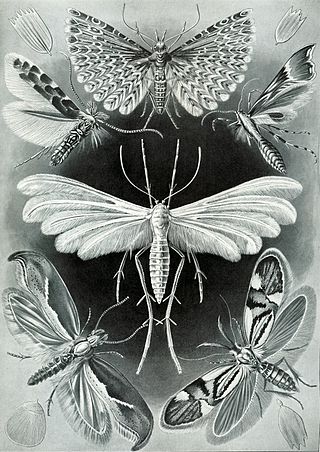
Microlepidoptera (micromoths) is an artificial grouping of moth families, commonly known as the "smaller moths". These generally have wingspans of under 20 mm, so are harder to identify by external phenotypic markings than macrolepidoptera. They present some lifestyles that the larger Lepidoptera do not have, but this is not an identifying mark. Some hobbyists further divide this group into separate groups, such as leaf miners or rollers, stem or root borers, and then usually follow the more rigorous scientific taxonomy of lepidopterans. Efforts to stabilize the term have usually proven inadequate.
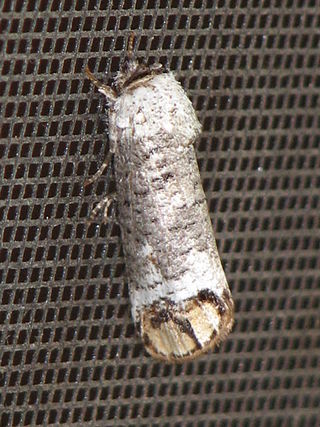
The Cossidae, the cossid millers or carpenter millers, make up a family of mostly large miller moths. This family contains over 110 genera with almost 700 known species, and many more species await description. Carpenter millers are nocturnal Lepidoptera found worldwide, except the Southeast Asian subfamily Ratardinae, which is mostly active during the day.
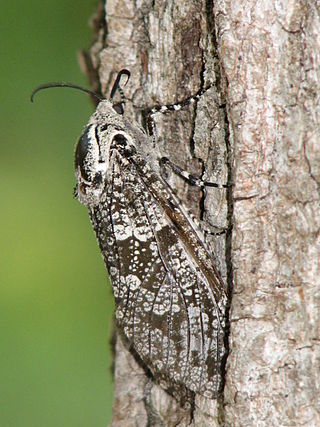
The Cossinae are the nominate subfamily of the Cossidae. The caterpillars of several Cossinae species, such as the carpenterworm and the goat moth, are significant pests. On the other hand, in Chile the caterpillars of the Chilean moth are collected on a commercial scale for sale as fishing bait and terrarium pet food; they are usually called "butterworms" in international trade.

Acossus centerensis, the poplar carpenterworm, is a moth of the family Cossidae. It is found in North America from New Jersey west to Illinois and North Dakota. In Canada it is found from Quebec and Ontario west to British Columbia.
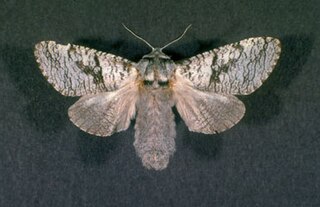
Acossus populi, the aspen carpenterworm, is a moth of the family Cossidae. It is found in the United States in Nevada, Colorado, California and in the northern Rocky Mountains. In Canada it is found in Ontario and British Columbia.
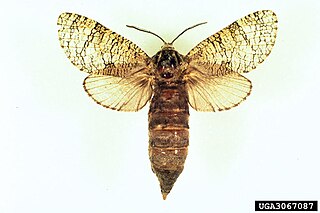
Prionoxystus macmurtrei, the little carpenterworm moth, is a moth of the family Cossidae. It is found from Ontario and Quebec to Florida, west to Texas, north to Minnesota.

Prionoxystus robiniae, the carpenterworm moth or locust borer, is a moth of the family Cossidae. It was first described by Peck in 1818 and it is found in southern Canada and most of the United States.

Cossula magnifica, the pecan carpenterworm moth, is a moth of the family Cossidae found in the southeastern parts of United States, from North Carolina south to Florida, and west to Mississippi and Texas.

Acossus terebra is a species of moth of the family Cossidae. It is found in Eurasia, including Israel, Turkey, northern Spain, central and southern Europe, southern Sweden, Finland, the Baltic region, Ukraine, the central part of European Russia, the Caucasus, southern Siberia to southern Yakutia, the southern part of the Russian Far East, Korea, Heilongjiang, Jilin and inner Mongolia.
Acossus undosus is a species of moth of the family Cossidae. It is found in the United States, including Wyoming, Utah and possibly surrounding states.
Acossus viktor is a species of moth of the family Cossidae. It is found in Russia, in southern Siberia and the southern part of the Tuva Republic.
Fania connectus is a species of moth of the family Cossidae first described by William Barnes and James Halliday McDunnough in 1916. It is found in Texas in the United States.
Parahypopta radoti is a species of moth of the family Cossidae. It is found in France.
Catopta is a genus of moths in the family Cossidae.
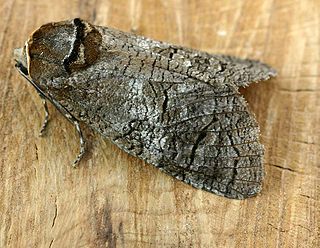
Cossus is a genus of moths in the family Cossidae described by Johan Christian Fabricius in 1793.
Prionoxystus piger, the baccharis carpenterworm moth, is a moth in the family Cossidae. It was described by Augustus Radcliffe Grote in 1865. It is found in Florida and Cuba.
Inguromorpha basalis, the black-lined carpenterworm moth, is a moth in the family Cossidae. It is found in North America, where it has been recorded from the south-eastern United States, from New Jersey south to Florida and west to Missouri and Arkansas.

Givira lotta, the pine carpenterworm moth, is a moth in the family Cossidae. The species was first described by William Barnes and James Halliday McDunnough in 1910. It is found in the United States, where it has been recorded from California, Arizona, New Mexico and Colorado. The habitat consists of pine forests.

The Zeuzerinae are a subfamily of the family Cossidae.










